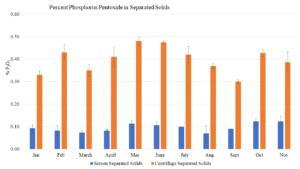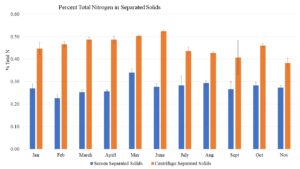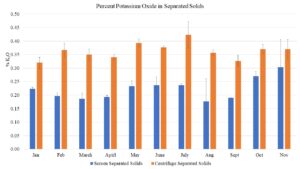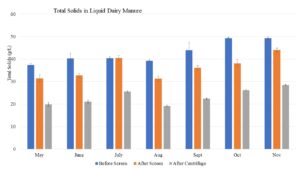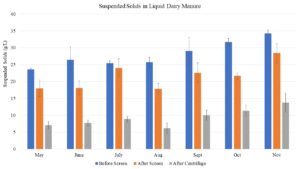Final report for SW18-015
Project Information
Solids and nutrients found in liquid manure pose challenges to manure handling processes and cause environmental concern. Separating solids and nutrients from liquid manure is a critical step in reducing manure handling costs, enabling better use of nutrients and water, controlling odor and gas emissions from manure storage lagoons and manure irrigated lands, and reducing pollution potential to ground and surface waters caused by manure, thus supporting the sustainability of the dairy industry. This project will be the first to evaluate and compare centrifuge and disk filtration separation technologies with a commonly used screen separation method to provide research-based information to help dairy producers make informed decisions. The purpose of this project is to demonstrate, evaluate, and encourage the widespread adoption of the centrifuge and disk filtration solid/nutrient separation technologies, resulting in a more sustainable dairy industry. The approach combines on-farm evaluation, lab tests, cost analysis, and extension activities. The project will demonstrate the centrifuge and disk filtration effects on the capture of solids, nitrogen, and phosphorous and on mitigating ammonia emissions. The cost effectiveness of each technology will be analyzed to provide critical economic information for Idaho and western region dairy producers. The expected outputs and outcomes include: 1) assessment of solids, nitrogen, and phosphorous separation efficiencies; 2) assessment of ammonia emissions from both treated and untreated liquid dairy manure; 3) analysis of costs associated with the demonstrated technologies; 4) field days and producer workshops; 5) development of scholarly publications and educational materials; and 6) increased knowledge, well-informed producers, and increased adoption of the demonstrated technologies.
(1) Evaluate efficiencies on capturing solids, N and P from liquid dairy manure by three different separation technologies (centrifuge, disk filtration, and inclined screen) under real farm operation conditions. This evaluation and comparison will provide producers research-based data for making informed decisions;
(2) Evaluate NH3 emissions from centrifuge, disk filtration, and inclined screen treated and untreated liquid manure to document their effects on mitigating NH3 emissions;
(3) Analyze costs associated with the demonstrated technologies to provide economic information to help producers make informed decisions;
(4) Develop scholarly publications and educational materials to encourage the widespread adoption of the demonstrated technologies in Idaho and the western states;
(5) Deliver four field days during this project period to demonstrate the manure solid/nutrient centrifuge and disk filtration separation technologies to familiar stakeholders with the demonstrated technologies;
(6) Conduct in-service training for Idaho statewide extension personnel to increase extension manpower;
(7) Hold three producer workshops to communicate the project results with dairy producers, resulting in increased awareness of the demonstrated technologies among farmers.
Cooperators
- (Researcher)
- (Researcher)
Research
1. Phosphorus in liquid dairy manure is mostly attached to finer particles smaller than 0.5mm in diameter;
2. Advanced liquid-solid separation such as centrifuge perform much better compared to commonly used inclined screens in terms of separating solids and N and P;
3. Solid separation reduces ammonia (NH3) emissions from liquid dairy manure.
For testing hypothesis 1:
Liquid dairy manure samples were collected from a flushing receiving pit on each of three dairies. Triplicate samples were analyzed for solid content, particle density, particle size distribution, total nitrogen (TN), and total phosphorus (TP). Solid content was analyzed based on Method 2540B (APHA, 2015). Particle density was analyzed based on the method ASTM D1217-15 (Weindorf and Wittie, 2003) using a pycnometer with a methanol medium for particle sizes of 4, 2, 0.5, 0.25, 0.125, 0.063, and <0.063 mm. Particle size distribution was determined using a set of 6 sieves (4, 2, 0.5, 0.25, 0.125, and 0.063 mm) combined with the hydrometer method ASTM D7928-17 (Days, 2002) for particle sizes less than 0.063mm. Nutrient parameters (TN and TP) were analyzed using a Hach spectrometer (DR 5000) based on Hach methods TNT880 (for TN) and TNT845 (for TP) (Hach, 2005). The Pipette Methods ASTM D6913/D6913M-17 (Hellman and McKelvey, 1941) was used in conjunction with ASTM D7928-17 to extract liquid manure samples for analyzing the nutrient parameters.
For testing hypothesis 2:
To obtain reliable results about centrifuge and screen separation efficiencies, liquid manure sampling and analysis will be repeated three times on three different dates in each of the four seasons. Each time, three liquid manure samples will be collected both before and after use of the centrifuge and screen from three cooperative dairies, respectively. The collected liquid manure samples will be kept in a cooler and immediately sent to a certified commercial lab, where solids, N and P concentrations in the liquid manure samples will be analyzed. At the same time, three separated solid samples from both the screen and the centrifuge will be collected. The collected solid manure samples will be kept in a cooler and immediately sent to the same commercial lab, where moisture content, N and P concentrations in the solid samples will be analyzed.
For testing hypothesis 3:
To obtain reliable results about the NH3 emission mitigation effects of the centrifuge and screen, NH3 emission tests will be conducted three times on three different dates in each of the four seasons. All sampling will take place at the three cooperative dairies. The collected liquid manure samples will be brought back to the University of Idaho (UI) Twin Falls Research and Extension Center Waste Management Laboratory where NH3 emission tests will be conducted outdoors near the lab to reflect seasonal-ambient effects.
The collected liquid manure will be well mixed before being distributed into five-gallon buckets with one gallon of manure in each bucket. Ogawa passive NH3 samplers (Ogawa & Co. USA, Inc., Pompano Beach, FL; Figure 1) will be used to determine the time-average concentrations of NH3 in the head space of the five-gallon buckets containing untreated (before the screen), screen-treated (after screen separator), and centrifuge-treated (after centrifuge) liquid manure. Four buckets in each category: (1) untreated, (2) screen-treated, and (3) centrifuge-treated liquid manure. A flow-injection analysis system (QuickChem 8500, Lachat Instruments, Milwaukee, WI) will be used to analyze NH4-N extracted from the passive sampler filters, which will have trapped NH3 in the head space of each bucket.
The process for collecting and analyzing passive sampler samples is briefly stated as follows. First, after buckets have been filled with manure as described above, all buckets will be covered with lids. Two two-inch holes will be made in each lid for placing passive samplers into and pulling passive samplers out of the headspace of each bucket. Five passive samplers will be placed into each of the buckets. At 2, 4, 8, 12, and 24 hours after placing the passive samplers, a passive sampler sample will be collected from each bucket. Immediately after pulling the passive samplers, sampler filters will be transferred using clean forceps into individual 15-ml centrifuge tubes. The filters in each centrifuge tube will be extracted using 5 ml 1 M KCI (potassium chloride) for 30 minutes in a reciprocating shaker. The extractant will then be filtered with 0.45 μm filter discs into 8 ml glass culture tubes. The filtered extractant will be analyzed for NH3 using the QuickChem 8500 system.
Flushing liquid dairy manure solid particle densities of three dairies are shown in Figure 1. The particle densities of three dairies were found to be similar ranging from 1.32 g/cm3 for particle sizes larger than 4 mm to 2.20 g/cm3 for particles less than 0.063 mm.

Flushing liquid dairy manure solid particle distributions of three dairies are shown in Figure 2. It was noticed that high bedding fibers were presented in the liquid manure from Dairy DD which resulted in a higher percentage 32.6% of solids with particle sizes larger than 4 mm. For both Dairy SF and Dairy SE, the percentages of solids (dry weight basis) with particle sizes larger than 4mm were 8% (=19.5/240.9) and 17.2% (=26/150.7), respectively. Most mesh sizes of inclined screens used on Idaho dairies were larger than 0.5 mm. The percentages of solids (dry weight basis) with particle sizes larger than 0.5mm were 20.7%, 48.9%, and 33% for dairies SF, DD, and SE, respectively. The percentages of solids (dry weight basis) smaller than 0.001 mm that remained in liquid stream were 45.6%, 29.5% and 37.8% for Dairy SF, Dairy DD, and Dairy SE, respectively.
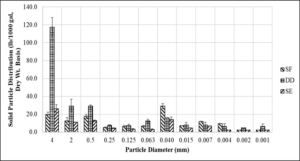
Flushing liquid dairy manure total nitrogen (TN) and total phosphorus (TP) associated with different particle groups are shown in Figures 3 and 4. TN and TP distributions varied from dairy to dairy. There were 33.6% and 43.9% of TN associating with particles larger than 0.5 mm for Dairy SF and Dairy SE, respectively. There were 17.8% and 19.4% of TN associating with particles smaller than 0.5 mm for Dairy SF and Dairy SE, respectively. There was 6.5% of TN attaching to particles larger than 0.5 mm and there were 33.3% of TN attaching to particles smaller than 0.5 mm for Dairy DD. Screen separation did better job on Dairy SF and Dairy SE in terms of capturing TN, but TN separation efficiency of screens on Dairy DD was low. Most TP was attached to fine particles with sizes less than 0.5 mm for the three dairies. In order to separate more TP out of liquid stream, advanced separation methods beyond inclined screens are needed.
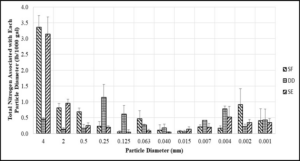

A total of 45 solid and liquid manure samples were collected before and after centrifuges and inclined screens from three collaborating dairies in December 2018 and these manure samples were analyzed for solids, N and P. These analyzed data will be used to evaluate efficiencies on capturing solids, N and P from liquid dairy manure by two different separation technologies.
Liquid dairy manure samples were collected before and after centrifuges and inclined screens from three collaborating dairies in December 2018 for evaluating ammonia emissions from centrifuge and inclined screen treated and untreated liquid manure. A total of 160 NH3 emission test samples were analyzed. These data will be used to evaluate effects of centrifuges and screens on mitigating NH3 emissions.
We will continue both the evaluation of efficiencies on capturing solids, N and P and NH3 emission test monthly in 2019.
Summary for 2019:
In 2019, the project team focused on on-farm manure sampling, lab ammonia emission test, and evaluation of efficiencies on capturing solids, N and P from liquid dairy manure by four different separation methods under real farm operations. A Post-Doc researcher focused on lab tests and data analyses. A research technician spent much of his times on on-farm manure sampling and lab tests. Evaluation of efficiencies on capturing solids, N, and P from liquid dairy manure by centrifuges, inclined screens, a disk-filtration system, and a sand-filtration system was conducted monthly on five commercial dairies. Tests on ammonia (NH3) emissions from centrifuge, inclined screen, and disk-filtration treated and untreated liquid dairy manure from four dairies were carried out monthly in the PI’s Waste Management Laboratory. The team has started collecting information related to costs associated with both the centrifuge and inclined screen separation. We presented the results of liquid dairy manure solid/nutrient distribution tests at 5 local producer workshops in February 2019, 2019 Waste to Worth Conference in Minneapolis in April, and at 2019 ASABE Annual International Meeting in Boston in July. A peer-reviewed paper was published in the proceedings of 2019 Waste to Worth Conference. Three peer-reviewed journal papers were published.
Accomplishment/Milestones in 2019
Over 500 solid and liquid manure samples were collected before and after centrifuges, inclined screens, disk-filtration system, and sand-filtration system from five collaborating dairies in 2019 and these manure samples were analyzed for solids, N and P. Over one thousand ammonia test samples were collected and analyzed. These analyzed data will be used to evaluate efficiencies on capturing solids, N and P from liquid dairy manure by four different separation methods, and to evaluate NH3 emissions from the four separation methods treated and untreated liquid dairy manure.
We presented the liquid dairy manure solid and nutrient distribution results at 5 producer workshops and two national conferences.
Three peer-reviewed journal papers were published:
- Wang, L., L. Chen, S. Wu, and A. Krosuri. 2019. Non-airtight fermentation of dairy manure with waste potato peels and subsequent phosphorus recovery via struvite precipitation. Applied Biochemistry and Biotechnology (https://doi.org/10.1007/s12010-019-03133-8)
- Wang, L., L. Chen, and S. Wu. 2019. Nuntrient reduction of dairy manure through solid-liquid separation with flocculation and subsequent microalgal treatment. Applied Biochemistry and Biotechnology (https://doi.org/10.1007/s12010-019-03185-w)
- Wang, L., L. Chen, S. Wu, and J. Ye. 2019. Non-airtight fermentation of sugar beet pulp with anaerobically digested dairy manure to provide acid-rich hydrolysate for mixotrophic microalgae cultivation. Bioresource Technology 278 (2019) 175-179. (https://doi.org/10.1016/j.biortech.2019.01.075)
A peer-reviewed proceedings paper entitled “Flushing liquid dairy manure solid particle and nutrient distributions” was published in the Proceedings of the 2019 Waste to Worth Conference, April 22-26, 2019.
We have got many test data but haven’t dug deep into these data for solid conclusions which will be carried out in 2020. Based on preliminary observations, centrifuge separated solids have higher phosphorus concentrations than that in screen separated solids and there were no obvious effects on mitigation of ammonia emissions from liquid dairy manure by the tested separation methods.
Summary for 2020
In 2020, the project team focused on data analyses and also spent some time on on-farm manure sampling, lab ammonia emission test, and evaluation of efficiencies on capturing solids, N and P from liquid dairy manure by four different separation methods under real farm operations. A Post-Doc researcher focused on lab tests and data analyses. A research technician spent much of his times on on-farm manure sampling and lab tests. A graduate student joined in lab tests and data analyses too. The team interviewed dairy producers and made an educational video on centrifuge uses as a secondary solid separation technology. We communicated the project findings with individual dairies and presented the results at local, regional, and national conferences such as Idaho Ag Talk, Pacific Northwest and Mountain West Nutrient Cycling, Soil Health, and Food Safety Conference, ASABE Annual International Meeting. Two peer-reviewed journal papers were published.
It is noticeable that the screen separated solids are undigested fibers while the centrifuge separated solids are finer particles. Phosphorus, nitrogen, and potassium in centrifuge and screens separated solids are shown in Figures 5, 6, and 7. It came across that P concentration in the centrifuge separated solids is much higher than that in the screen separated solids. A year long averages of total nitrogen and potassium in centrifuge separated solids are higher than that in screen separated solids too.
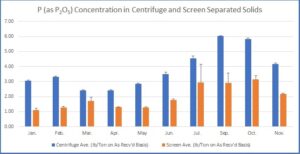
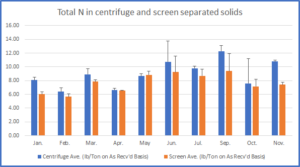
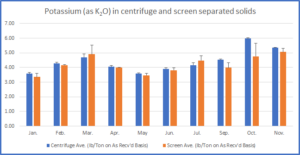
Phosphorus (as P2O5), TN, and K (as K2O) concentrations in liquid stream before the screens, after the screens, and after the centrifuge are shown in Figures 8, 9, and 10, respectively.
Though the P, N, and K concentrations in liquids before and after the screen and centrifuge treatments were not much different, the amounts of P, N, and K removal from liquids were still large numbers because of the huge amounts of liquid (i.e., 10 million gallons).
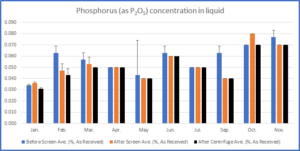

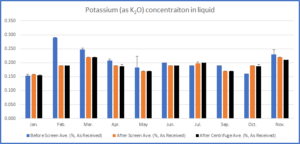
Ammonia emissions from liquid manure before screens, after screens, and after centrifuge. Ammonia emissions from raw liquid manure, screen and centrifuge separated liquid manure did not show significantly differences. The most influential factor for ammonia emissions from liquid manure was ambient temperatures.
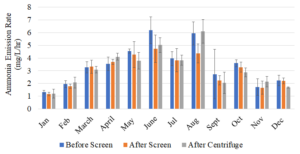
Accomplishment/Milestones in 2020
Two peer-reviewed journal papers were published:
Wang, L., L. Chen, and S. Wu. 2020. Dairy manure wastewater remediation using non-airtight digestion pretreatment followed by microalgae cultivation. Applied Biochemistry and Biotechnology. DOI: 10.1007/s12010-020-03363-1
Wang, L., L. Chen, and S. Wu. 2020. Microalgae cultivation using screened liquid dairy manure applying different folds of dilution: nutrient reduction analysis with emphasis on phosphorus removal. Applied Biochemistry and Biotechnology 192(2), 381-391 (https://doi.org/10.1007/s12010-020-03316-8)
A peer-reviewed University of Idaho extension bulletin paper entitled “Estimating the Efficiency and Cost of an On-Farm Centrifuge Separator” has been accepted. A video titled “Video titled Secondary Solid Separation Technology for Dairy: Centrifuge” has been developed and presented at the 2020 Pacific Northwest and Mountain West Nutrient Cycling, Soil Health, and Food Safety Conference.
Summary for 2021 and 2022
In 2021 and 2022, the project team focused on data analyses, developing educational materials, and communicating project results with stakeholders. We communicated the project findings with individual dairies and presented the results at local, regional, national, and international conferences such as Idaho Ag Talk, 2021 University of Idaho Manure Management Workshop, 2021 EPA Region 10 CAFO Workshop, 2021 ASABE Annual International Meeting, 2021 International Symposium on Animal Environment and Welfare, 2022 Waste to Worth Conference. Two peer-reviewed Extension publications and a MS Thesis were produced.
Phosphorus, nitrogen, and potassium in centrifuge and screens separated solids are shown in Figures 12, 13, and 14. It came across that P concentration (a yearlong average of 8.0 lb/ton) in the centrifuge separated solids is much higher than that (a yearlong average of 2.0 lb/ton) in the screen separated solids. A yearlong average of 9.2 lb/ton of total nitrogen in centrifuge separated solids was measured while a yearlong average of 5.4 lb/ton of total nitrogen was observed in screen separated solids. Potassium (K2O) in centrifuge separated solids were higher than that in screen separated solids too (a yearlong average of 7.2 lb/ton in centrifuge separated solids vs. 4.4 lb/ton in screen separated solids).
Figure 12. Phosphorus in centrifuge and screen separated solids.
Figure 13. Total nitrogen in centrifuge and screen separated solids.
Figure 14. Potassium in centrifuge and screen separated solids.
As shown in Figures 15 and 16, total solids and suspended solids were reduced after screen and centrifuge treatment.
Figure 15. Total solids in raw (before screen), after screen, and after centrifuge.
Figure 16. Suspended solids in raw manure (before screen), after screen, and after centrifuge.
Our test results show that the most influential factors for ammonia emissions from liquid manure were ambient temperatures and suspended solids within the liquid dairy manure.
Figure 17 shows a positive correlation between ammonia emission rate and ambient temperature. A negative correlation between the ammonia emission rate and suspended solids within liquid dairy manure was observed (Figure 18.)
Figure 17. Ammonia emission rate vs. ambient temperature.
Figure 18. Ammonia emission rate vs. suspended solids in liquid dairy manure.
Accomplishment/Milestones in 2021 and 2022
Three peer-reviewed Extension papers were published:
Chen, L. 2021. A centrifuge improves flushed liquid dairy manure separation efficiencies for solids and nutrients. Journal of Nutrient Management (available at https://issuu.com/hoardsdairyman/docs/jnm_q1_feb_2021_digital/s/11890723).
Chen, L., L. Schott. 2021. Should Producers Test Solid Dairy Manure and Dairy Manure Compost Before Land Application. UI Extension BUL 997 (available at BUL997 Should Producers Test Solid Dairy Manure and Dairy Manure Compost Before Land Application? (uidaho.edu))
Chen, L., H. Tejeda. 2021. Estimating the Efficiency and Cost of an On-Farm Centrifuge Separator. UI Extension BUL 991 (available at BUL991 Estimating the Efficiency and Cost of an On-Farm Centrifuge Separator (uidaho.edu))
A MS thesis entitled “Particle density, particle size, and nutrient distribution of flushed dairy manure” has been published by Bishnu Pandey.
Three storyboard talk videos
Zong Liu and L. Chen. 2022. Storyboard talk, available at Visit with a Dairy Facility Manager Episode 1 : Manure Treatment in Bettencourt Dairy - YouTube
Zong Liu and L. Chen. 2022. Storyboard talk, available at Visit with a Dairy Facility Manager Episode 2: Screen and Centrifuge Management - YouTube
Zong Liu and L. Chen. 2022. Storyboard talk, available at Visit with a Dairy Facility Manager Episode 3: Main Goals and Challenges in Dairy Manure Management - YouTube
- Liquid dairy manure particle densities ranged from 1.30 g/cm3 to 1.49 g/cm3, which is smaller than commonly used soil’s density (2.65 g/cm3).
- The majority of solids and TN/TP belong to finer particles.
- The percentages of solids, TN, and TP associated with particle sizes larger than 0.5mm ranged from 25% to 37%, 24% to 38%, and 14% to 39%, respectively.
- Advanced separation technologies such as centrifuges are needed to capture more solids and nutrients.
- Centrifuge can further remove finer particles that can not be removed by primary screens.
- Centrifuge separated solids contained higher N, P, and K, especially P (an average of 8 lb/ton Vs. 2 lb/ton of P2O5).
- Ammonia emissions from raw liquid manure, screen and centrifuge separated liquid manure did not show significant differences.
- The most influential factors for ammonia emissions from liquid manure were ambient temperatures and suspended solids within the liquid dairy manure.
Research outcomes
Education and Outreach
Participation summary:
We presented the results of liquid dairy manure solid/nutrient distribution tests at a producer workshop in August 2018 and at the Idaho Nutrient Management Conference in November 2018.
A peer-reviewed proceedings paper entitled “Liquid dairy manure solid distribution” was published in the Proceedings of Idaho Nutrient Management Conference, November 15, 2018.
We presented the project results at Idaho Cereal School in February 2019, Waste to Worth conference in April 2019 and 2022, ASABE Annual International Meeting in July 2019, virtual 2020 and 2021 ASABE Annual International Meeting, 2020 Idaho Ag Talk, virtual 2020 Pacific Northwest and Mountain West Regional Nutrient Cycling, Soil Health, and Food Safety conference, 2021 University of Idaho Manure Management Workshop, 2021 EPA Region 10 CAFO Workshop, 2021 International Symposium on Animal Environment and Welfare, and numerous individual farm visits.
About 600 hundreds of producers and 800 agricultural professionals participated in these events.
Eight peer-reviewed journal and Extension papers were published:
-
Wang, L., L. Chen, and S. Wu. 2020. Dairy manure wastewater remediation using non-airtight digestion pretreatment followed by microalgae cultivation. Applied Biochemistry and Biotechnology. DOI: 10.1007/s12010-020-03363-1
-
Wang, L., L. Chen, and S. Wu. 2020. Microalgae cultivation using screened liquid dairy manure applying different folds of dilution: nutrient reduction analysis with emphasis on phosphorus removal. Applied Biochemistry and Biotechnology 192(2), 381-391 (https://doi.org/10.1007/s12010-020-03316-8)
- Wang, L., L. Chen, S. Wu, and A. Krosuri. 2019. Non-airtight fermentation of dairy manure with waste potato peels and subsequent phosphorus recovery via struvite precipitation. Applied Biochemistry and Biotechnology (https://doi.org/10.1007/s12010-019-03133-8)
- Wang, L., L. Chen, and S. Wu. 2019. Nuntrient reduction of dairy manure through solid-liquid separation with flocculation and subsequent microalgal treatment. Applied Biochemistry and Biotechnology (https://doi.org/10.1007/s12010-019-03185-w)
- Wang, L., L. Chen, S. Wu, and J. Ye. 2019. Non-airtight fermentation of sugar beet pulp with anaerobically digested dairy manure to provide acid-rich hydrolysate for mixotrophic microalgae cultivation. Bioresource Technology 278 (2019) 175-179. (https://doi.org/10.1016/j.biortech.2019.01.075)
-
Chen, L. 2021. A centrifuge improves flushed liquid dairy manure separation efficiencies for solids and nutrients. Journal of Nutrient Management (available at https://issuu.com/hoardsdairyman/docs/jnm_q1_feb_2021_digital/s/11890723).
Chen, L., H. Tejeda. 2021. Estimating the Efficiency and Cost of an On-Farm Centrifuge Separator. UI Extension BUL 991 (available at BUL991 Estimating the Efficiency and Cost of an On-Farm Centrifuge Separator (uidaho.edu))
Chen, L., L. Schott. 2021. Should Producers Test Solid Dairy Manure and Dairy Manure Compost Before Land Application. UI Extension BUL 997 (available at BUL997 Should Producers Test Solid Dairy Manure and Dairy Manure Compost Before Land Application? (uidaho.edu))
Chen, L., K. Kruger, and H. Neibling. 2019. Flushing liquid dairy manure solid particle and nutrient distributions. Proceedings of the 2019 Waste to Worth Conference. Minneapolis, Minnesota, April 22-26, 2019. Available at: https://lpelc.org/flushing-liquid-dairy-manure-solid-particle-and-nutrient-distributions/
Chen, L., K. Kruger, and H. Neibling. 2018. Liquid dairy manure solid distribution. Proceedings of the Idaho Nutrient Management Conference. Twin Falls, Idaho, November 15, 2018. P. 32-37.
Chen, L. 2021. Evaluation of on-farm centrifuge and screen on removing solids and nutrients from liquid dairy manure. Ag Talk Report-September 2021, VOV. 3 ISS. 2. Available at: Ag Talk Tuesday | University of Idaho Extension (uidaho.edu)
Chen, L. 2020. Solid dairy manure and dairy manure compost nutrient survey results. Ag Talk Report-August 2020, VOV. 2 ISS. 5. Available at: https://webpages.uidaho.edu/extension-seed-potato/ATT.html
Chen, L. 2020. Solid dairy manure nutrient survey. Ag Proud Idaho-March 2020. Available at: https://www.agproud.com/digital-edition/2020/03/viewer/desktop/#page/24
Chen, L. 2020. Centrifuge solid separation-reducing solid accumulation in liquid storage systems. Available at: https://static1.squarespace.com/static/5980acf9197aea5e857a81eb/t/5b9689f140ec9a30c759b9da/1536592421443/Manure+Separation+Notes_WEB.pdf
Chen L. 2020. Video on secondary solid separation technology for dairies: centrifuge. Available at centrifuge video FINAL - YouTube
-
Zong Liu and L. Chen. 2022. Storyboard talk, available at Visit with a Dairy Facility Manager Episode 2: Screen and Centrifuge Management - YouTube
-
Chen, L. 2018. Manure Tech Talks-Measuring the efficiency & financial feasibility of a centrifuge separator. IDA producer workshop hands-out brochure.
-
Bishnu Pandey. 2021. Particle density, particle size, and nutrient distribution of flushed dairy manure. MS Thesis, University of Idaho.
- Chen, L. and K. Kruger. 2022. “Effects of centrifuges and screens on separating solids and nutrients and on affecting ammonia emissions from liquid dairy manure.” Proceedings of the 2020 Waste to Worth Conference, April 18-22, 2022.
Education and Outreach Outcomes
- Liquid dairy manure solid/nutrient distribution
Liquid dairy manure solid/nutrient distribution
